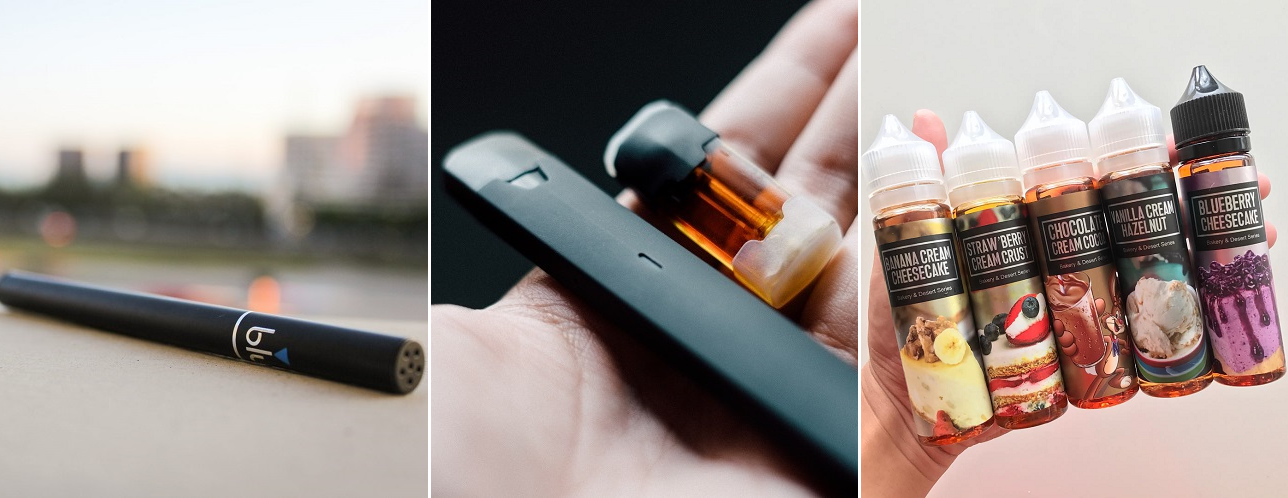A couple of weeks ago, the NYLON team discovered Broken, an investigative docu-series (now streaming on Netflix), which offers an insight into how negligence and deceit can play a part in the production and marketing of popular consumer products.
The second episode of the series on vaping and e-cigarettes got the team into a discussion on whether we knew anyone who had taken up vaping, and if there was a grey area in the law that permits the use of this popular smoking alternative here since there have also been several news articles on individuals vaping in public.
Earlier this year, we were faced with the same confusion on the use of Cannabis Hemp Seed Oil in cosmetic products in Singapore, and were wondering if they were considered legal to be sold here. We reached out to the Central Narcotics Bureau (CNB) with this query and were told that it was deemed as an illegal substance.
Hence, the reason for this article. We wanted to ascertain just where the Singapore government stands on the use and ownership of vapourisers and e-cigarettes; and if it was actually easy to obtain them locally.
E-cigarettes and Vaporisers are not the same

Though they are both electronic battery-operated devices that emit vapour, they are most definitely not one and the same.
E-Cigarette is shaped like a cigarette with the ability to heat up a solution made up of nicotine, flavourings and other chemicals that turns into an inhalable mist. The thin size doesn’t allow for the device to accommodate anything else which means users would have to frequently dispose the cartridge which stores the liquid.
Vaporisers, or affectionately known by its users as Vape Pens, is slightly larger in size with the ability to heat a range of interchangeable flavoured liquid (or ‘vape juice’, if you are in the know) that usually contains nicotine, flavourings, and other chemicals. Their larger build allows for them to have longer battery life as well as space for a mini tank to change flavours, or add additional liquid and nicotine as per the user’s preference. Interestingly enough, vape pens can also be modified to accommodate the use of street formulated liquid that contain THC or marijuana.
How did e-cigarettes and vape pens get so popular?
There’s a simple answer to that, really, and it is smart marketing.

The idea of e-cigarettes and vape pens first started to gain traction when they were marketed by manufacturers as a means to help smokers break the addiction to tobacco.
It was easy to fall for the gimmick because the idea wasn’t to lay off smoking completely. The concept behind the e-cigarette made it easy for current smokers to believe that they were using a ‘healthier option’ which allowed for them to enjoy the same kicks as a traditional cigarette but at a lower risk. To top it off, e-cigarettes were also being marketed as a form of lifestyle product that added to the status of an individual.
While the plan was to target adult smokers to make the switch from traditional to electronic, the user demographic started to see a shift in an unexpected direction when JUUL came onto the market in 2015.

Embarking on their next big project, Juul Labs (formerly named Pax Labs) created JUUL, a vape pen that not only looked aesthetically pleasing with its Apple-inspired sleek exterior, but was also compatible with JUUL’s variety of flavoured liquid which included Strawberry Milk, Cappuccino, and Mango.
Though Juul Labs hadn’t outrightly identified the profile of their potential customers, it is hard to look past the amount of youth-related imagery that was used to market their product during their first launch in 2015-2016.
Not only were they using bright colours in their advertisements, but they had created familiar scenarios with young, attractive models that displayed teen behaviour and characteristics while holding onto the flash-drive shaped device.
While it could be argued that the campaign images were used to give the brand a youthful association, it is hard to look past their youth-oriented tactics which tapped on the social media savviness of youths to help spread the word of their new product.
If it is like smoking, what is wrong with doing that here in Singapore?
Although vape pens and e-cigarettes are not exactly under strict regulations in countries like the USA and the UK, it is, however, a very different story here in Singapore.

Since 1 February 2018, under section 16(2A) of the Tobacco (Control of Advertisements and Sale) Act (TCASA), it is illegal to possess, purchase or use either of these smoking alternatives in any way, shape or form. Anyone caught violating this law is subjected to a fine of up to $2,000.
Despite having this law in place, it still hasn’t stop resourceful individuals from successfully procuring one of their own from underground dealers at physical shops using code words such as ‘cartridges’ or ‘juices’, or even in the comfort
of their home, online.
Wait, like online shopping sites?
Yes, when we say online, we’re not only referring to the shady vape sites but also legitimate online shopping sites like Qoo10, Taobao, and even Lazada (if you know the right keywords to search).


Loophole… not.
You see, what most don’t really know is that there already is an enacted law placed under section 16(1) of the TCASA since 1 August 2016, which states that it is against the law to import vaporisers into Singapore, even if you are purchasing it for your personal use. Compared to section 16(2A), guilty parties face a stiffer fine of up to $10,000 and/or up-to six months in jail, with repeat offenders facing double the punishment of $20,000 and/or up-to 12 months of jail time.
However, even with this act in place, many still don’t seem to worry about the very real legal implications that can come with owning, or trying to own an e-cigarette or a vape pen.
Most electronic vaporisers and related accessories that were ordered online from overseas sellers to Singapore had been shipped using false descriptions such as toys, facial, and electronics to avoid detection or suspicion at customs.
Although there hasn’t been a revealed number of foiled or successful attempts since the discovery of this concealment method, there has, however, been an increase in the number of arrests made.

Just three months ago in September, a 35-year-old man was arrested and fined $99,000 (the highest fine ever imposed) by the Health and Sciences Authority (HSA) for the sale of electronic vaporisers using an online business site where he advertised his products and covered up sales transactions using the bogus sale detail, ‘computer IT services’.
Perhaps what should scare the ordinary citizen into thinking twice is that these two laws don’t just allow for the prosecution of dealers and wholesalers.
Over 465 people have been caught for the sale and possession of these devices including individual buyers, which was a likely result of the HSA’s recent close ties with popular online social platforms such as Carousell and Instagram, to monitor illegal sales and ownership.
Why is the Singapore government hell-bent on being such a buzzkill?
The reason is simple.
As shared by the Senior Parliamentary Secretary for Health and Home Affairs Amrin Amin, the enacted law is a form of “comprehensive ban that is intended to protect the public from the harms of emerging tobacco products”.
There just hasn’t been enough research done to determine a suitable regulation to be put in place to monitor the quality and safety of such smoking devices. It is almost similar to the stance CNB took with Cannabis Hemp Seed Oil because the health ministry doesn’t have any suitable process in place that can detect the presence of potentially harmful substances, or if any kind of contamination has occurred during the manufacturing process.

Despite all that e-cigarettes and vape pens are pegged out to be, they are also still harmful to the body. Nicotine is a toxic ingredient in the solution of these devices, and it can harm parts of the brain that controls your attention, memory, and learning. Long term usage could also result in the permanent lowering of impulse control, which doesn’t bode well for a growing teenager; or anyone for that matter.
Perhaps the most worrisome fact of it all is that nicotine is proven to be highly addictive, which is why it poses a big problem for most young vape and e-cigarette users.

In addition to that, this past year has already seen an alarming rise in the number of mysterious vape-related illnesses and lung injuries, which has seen healthy teens sent to emergency rooms with unexplainable symptoms such as severe shortness of breath, several days of vomitting, fever, and fatigue.
In the US alone, there have been at least 47 deaths and over 1,000 cases that were reported in relation to vaping. Such cases included a 17-year-old Michigan teenager who underwent a double lung transplant after his own lungs suffered an enormous amount of inflammation and scarring from his prolonged use of a vape device.
Though it may have initially seemed like an over-reaction on the government’s part (like the whole fiasco with PMDs), the increasing health risks that threaten each vape pen and e-cigarette user has warranted a legitimate reason for the serious recent crackdown.
The future regulation of vape pens and e-cigarettes in Singapore
At the moment, that’s a firm no from the authorities, even when Singapore has yet to report on any vape-related incidents. However, that does not mean they are not open to reviewing the regulations again when there is sufficient and credible evidence to support the use of such devices.
Granted, the regulation does not stop using individuals from obtaining their supplies through other means such as the black market, but the laws still act as a barrier which limits curious non-smokers and underage individuals from potentially gaining free access to them; since this is the group that is more susceptible to picking up vices due to peer pressure and the fear of being left out.
Of course, with such reasoning comes the debate on traditional cigarette regulations since they pose as much of a temptation as these less harmful smoking alternatives. If there could be an age restriction on the sale of cigarettes, why not impose it on vape pens and e-cigarettes?

It is hard to grant a proper regulation on something that you know so little of. Apart from the knowledge that marketers have been imparting to their audience, there have been no conclusive results thus far with regard to the actual safety and use of such devices.
Not only are governing bodies already dabbling with something that is fairly unknown, but they also have to take into account the bad rep that vaporisers and e-cigarettes have been getting from the press. Until all these unknown factors can be consolidated and addressed, a stiff regulation definitely seems like a more practical approach for the local governing body.
Whether you’re for or against the hard rules, just remember this: Singapore has a crystal-clear stance on these smoking alternatives and it is just not allowed.











You must be logged in to post a comment.